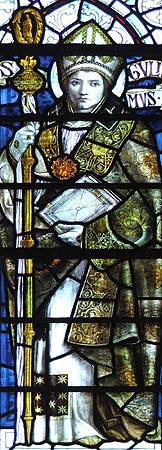
EBK Home
Kingdoms
Royalty
Saints
Pedigrees
Archaeology
King Arthur
Adversaries
Articles
For Kids
Mail David
 St. William FitzHerbert
St. William FitzHerbertof York, Archbishop of York
(Died 1154)
The father of William FitzHerbert, afterwards known as St. William of York, was Count Herbert, who had been Chamberlain and Treasurer to King Henry I. His mother, Emma, was a granddaughter of the Conqueror and half-sister of King Stephen and Henry of Blois, the powerful Bishop of Winchester.
Either because, as was asserted, Court influence had been strongly brought to bear on his election or for some other reason, which is nowhere made clearly evident, the election of William, in 1143, was violently opposed by the party of reformers in the Church, and especially by the Cistercians. The accusations against William were heard in Rome, by Pope Innocent, and a judgement was so far given in his favour that his consecration was permitted, provided that the Dean of York would state, on oath, that no undue influence had been exerted on the part of the King. This was done, not by the Dean, Hugh de Puiset, himself, who, meanwhile, had become Bishop elect of Durham, but by the Bishop of Orkney and the Abbots of St. Mary's (York) and Whitby on his behalf. So William was consecrated at Winchester, on 26th September 1143, by his uncle, Henry of Blois. In 1145, the pall was sent to him by Pope Lucius, who died in the same year.
The old Pope's successor was the Cistercian, Eugenius III. The archbishop's pall had not yet made it to England and the Cistercians, encouraged by St. Bernard of Clairvaux, revived the old charges. Archbishop William himself went to Rome. The cause was again tried and the Pope suspended the Archbishop until the late Dean of York should himself take the required oath. Meanwhile, certain followers of William, enraged at the treatment he was receiving from the Cistercians, attacked, plundered and burnt the monastery of Fountains. The Pope became altogether hostile and, at a council held at Rheims in 1147, he deprived William of his see.
After his deposition, Archbishop William found an asylum in the palace of his uncle at Winchester. Here, he entertained him in true Archiepiscopal style for five years, whilst the Abbot of Fountains, Henry Murdac, was elected Archbishop of York in his place. There he is said to have won all hearts by the gentleness and patience with which he bore his troubles. The chapter of York re-elected him on Murdac, Pope Eugenius and St. Bernard's deaths, which all occurred in 1153. He went, himself, to plead his cause in Rome, where the new Pope, Anastasius, accepted his election and gave him the pall. He was received at York, on his return, by a vast and rejoicing crowd; but, as the procession was crossing the River Ouse by a wooden bridge, it gave way and great numbers fell into the river. William is said to have saved them through a miracle and a chapel dedicated to him was afterwards built on the bridge of stone erected in the same place, The Archbishop was in York but thirty days. He celebrated mass on Trinity Sunday, but was taken ill during the service and died within a week - on 11th June 1194. It was said that poison had been mixed with the sacramental wine; but there is no evidence whatever of this and it seems tolerably certain that he died of rapid fever.
The church of York had as yet no saint peculiar to itself and was, accordingly, most anxious to procure the canonization of Archbishop William. This was not effected, however, until the pontificate of Nicholas Ill when the "money and urgent entreaties" of Anthony Bek, the magnificent Bishop of Durham (then only bishop elect), brought about the papal assent.
Edited from Richard John King's "Handbook to the Cathedrals of England: Northern Division" (1903).
